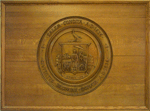House of the Seven Gables Settlement
According to the House of the Seven Gables website, "In the early 1900s, Salem witnessed an influx of immigrants, mostly of Polish and Eastern European descent. Recognizing the need for social services for the new Americans, Caroline O. Emmerton began a Settlement program to support and assist these new immigrants in their transition into American life and culture. Using Jane Addams’ Hull House in Chicago as her model, Emmerton's Settlement program focused on English language skills, vocational training, homemaking, nutrition, well-baby care, and early childhood education for the newly arriving immigrants and their children. Plays, pageants, and historical reenactments provided an understanding of American history and Salem’s place in the founding of the nation. For new immigrants, enrolling in these classes and programs meant making their way towards a better life in a new community.
To accomplish her social service work, Emmerton purchased the House of the Seven Gables, also known as the Turner Ingersoll Mansion, to generate revenue for her work. She purchased the house in 1908 and worked with historic preservation architect Joseph Chandler to transform the structure into a prime example of Colonial Revival architecture reflecting the tale outlined in Nathaniel Hawthorne’s novel, The House of the Seven Gables. Tourists flocked to The Gables to see the mansion and to learn more about Hawthorne and his life in Salem. Over the next 20 years, Emmerton purchased and restored more historic properties, adding to the site a collection of 17th, 18th, and 19th century structures."
Emmerton's settlement began in 1908 in the Seaman's Bethel, a small chapel donated by the Salem YMCA and located on the edge of the harbor in what is now the back yard of the House of the Seven Gables. Two years later, she bought the large house next door (the House of the Seven Gables), hoping to open it to visitors part of the year, expanding settlement programs and eventually using it as a residence for social workers. The settlement moved to a larger house on Turner Street in the 1930's and to its present location in Emmerton Hall in the late 1960's.
Emmerton envisioned the Gables as a tourist site where she could draw money to support a "settlement house" offering programs for the new immigrants, many from Poland. They came to work at the Pequot Mills. A portion of the admission price for the Gables goes to the settlement programs.
In the beginning, the settlement ran classes in English and citizenship for the newly arrived immigrants, and operated a medical clinic. It also offered programs in sewing, storytelling, gymnastics, cooking and woodworking. There was a glee club, a Little Folks Club, a travel club and a Neighborhood Social Club. The settlement ran a kindergarten long before the public schools. In the 1990's the settlement still ran a preschool, and after-school program, a day-care center, a summer camp, and programs for seniors.
Emmerton envisioned the settlement as a place for fellowship. "The settlement provides a place where the people from all sections can meet on an equal footing for mutual benefit and inspiration."
In 2010, the Gables board has reevaluated its existing programs and decided to make some changes. The preschool program was cut in 2009. The after school and camp programs were costly to run and had been declining in enrollment. Both of these programs, it was decided, duplicated services offered elsewhere. An advisory board was named and explored partnerships with other service providers.
According to their webiste:
The House of the Seven Gables and its Trustees have recently reaffirmed Emmerton’s visionary settlement model to better address the needs of the community in the 21st century. Today’s focus is on youth from immigrant communities, their families, and at-risk teens. Partnering with the Salem Public Schools and other like-minded non-profits, we are able to support this target population. Programs include English language instruction that builds reading, writing, vocabulary, and cognition skills; first jobs training that allows teens to earn a paycheck in a safe and supportive environment, while learning the skills necessary to keep a job; enrichment experiences that expose teens to the performing and visual arts while strengthening creativity, curiosity, and confidence; educational support in the form of scholarships, tutoring, SAT preparation, and college prep, to help each young person reach his or her full potential. Finally, The Gables Settlement Building is the home of the Salem Prep, Salem Public Schools’ alternative High School. This highly structured, intensive therapeutic learning environment provides an ideal environment for academic success, social/emotional growth, and vocational skill development in a small school environment."
In June 2016 The Gables sold Emmerton Hall (the former Settlement House) at 114 Derby St. They no longer used it for programming and it needed rehabbing to keep it viable. A developer made it into condos.
See Also
Vertical File in Salem Collection - House of the Seven Gables
Vertical File in Salem Collection - House of the Seven Gables Settlement
"Kids at play, kids at work; (summer camp program)" Boston Sunday Globe, July 31, 1994, p. N1
"Philanthropist's vision comes true" Salem Evening News, Apr. 28, 1990, p. 1
"Historic connection: exhibit celebrates 90-year relationship between House of Seven Gables, settlement house" Salem Evening News, Mar. 20, 1998, p. C8
"In centennial year, Gables shifts focus; agency eliminates children's programs and looks for mission to evolve" Salem News, Apr. 17, 2010, p. 1
"Emmerton Hall sale finalized, condo project to begin" Salem News, July 6, 2016, p. 1
